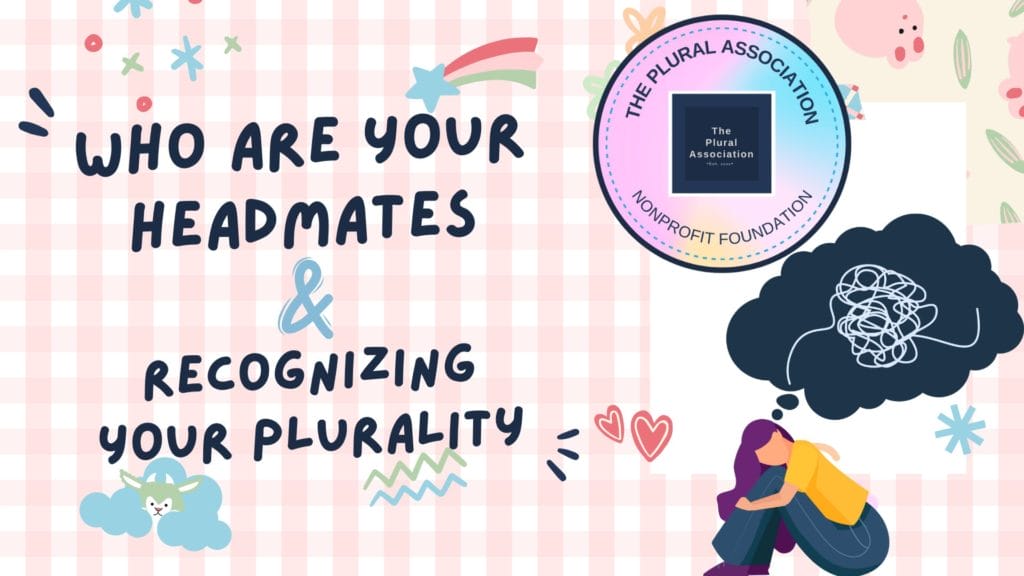|
TPA audio player
|
However, there are a few things that you can do to make the process of learning about everyone a little easier. It doesn’t have to be an entirely uphill battle – learning from the experiences of other Plurals and the journeys they’ve been on could be instrumental in helping you to evolve your understanding of your Plurality. Do note that the following is only a rough guide and, if you find that some of the steps don’t work for you, feel free to skip them or alter them however fits.
Identifying Who Is There
The first step is figuring out how many headmates there are in your Plurality. Sometimes many headmates can blend together or be difficult to identify, and if you want to learn more about them, disentangling their identities and personhood is crucial for getting to know and understand them better.
If your headmates are able to front, it may help to take some time and invite them all to front and document themselves as an individual. They don’t have to have figured out anything like their name, gender, sexuality, age, or anything of that sort – all that matters is establishing that this is a distinct consciousness that exists and deserves exploration.
“If you’re having troubles getting your headmate to front, you don’t have a headspace, your headspace doesn’t work in traditional ways, or are having difficulties exploring your headspace, take time to explore how many of these consciousnesses ‘feel’ different. Internal communication and sense aren’t entirely verbal and are not the same as outside communication. All of our brains have a different ‘language’ used for internal communication, and often that gets represented through emotions. Deciphering this is a crucial step for figuring out who everyone is.
Note that it’ll take time to identify how many there are, and that’s okay. There isn’t a rush on this, and no matter how long it may take you, you’re completely okay.
Figuring Out Unique Features
After you’ve figured out how many headmates you have, your next step should be figuring out what sets them apart. What are the names of each of your headmates? What species does your headmate identify with? What about their gender identity and sexuality? Do they have an age similar to the body, or different from it? Do they have a life distinct from the body in the headspace? Do they identify as being another person or being, fictional or otherwise?
There are quite a bit of questions that are worth going over, and it can seem overwhelming at first to figure out the answers to all of them for every headmate. The important thing to remember is to take it slow, and to realize that it’s okay to take your time and not have all the answers. Often, headmates may not have or know the answers to some of or all of the above questions. Alternatively, they may not be entirely comfortable sharing that information. All of this is okay – there’s no need to rush on any of this. Everyone needs their own time to adjust and figure this all out. You can’t reach the end of your journey without taking time to recuperate.
Our Questionnaire
If you’re having trouble structuring the questions you want to ask or figuring out what ones are fitting, we have a helpful checklist on getting to know your headmates here on Power to the Plurals. It goes over a majority of the questions you’ll want to ask, and provides a helpful structure to give you the guidance needed for figuring everything out.
The best part is that it’s free to use and readily available for everyone. It’s also translated into Russian, German, French, Dutch, and Spanish!
Conclusion
Figuring out who your headmates are is no easy task, but it’s not something you have to do in the dark. If you’re ever in need of resources and help in learning the ropes of everything, The Plural Association is here to help you with our resources and community. You aren’t in this alone, and you never have to be ever again.
As always, we encourage you and your System to follow your own truth, to soul search, to find words, labels, visions, theories and communities that aren’t only within your values but also match your lived experience and/or long term goals, so that you might find belonging and don’t have to try to fit in.
Thank you for investing the time to read this article. Please, feel free to leave comments or feedback in the comment section.
The Plural Association is the first and only grassroots, volunteer and peer-led nonprofit empowering Plurals. Our works, including resources like this, are only possible because of support from Plurals and our allies.
If you found this article helpful please consider making a donation.
Together we empower more Plurals!
Disclaimer: Thank you for reading our peer article; we hope it was empowering, informative and helpful for you and your System. There are as many Plural experiences, as there are Plurals. So not all information on this website might apply to your situation or be helpful to you; please, use caution. We’re not doctors or clinicians and our nonprofit, our work, and this website in no way provide medical advice, nor does it replace therapy or medication in other ways.
About the authors
Mira Lazine, also known as the Invariant System, is a system of roughly 80 headmates working to write about topics like science, gaming, politics, and plurality. You can find more of their works over on Twitter.
-
Mira Lazine (Invariant System)https://powertotheplurals.com/author/mira-lazine-invariant-system/

